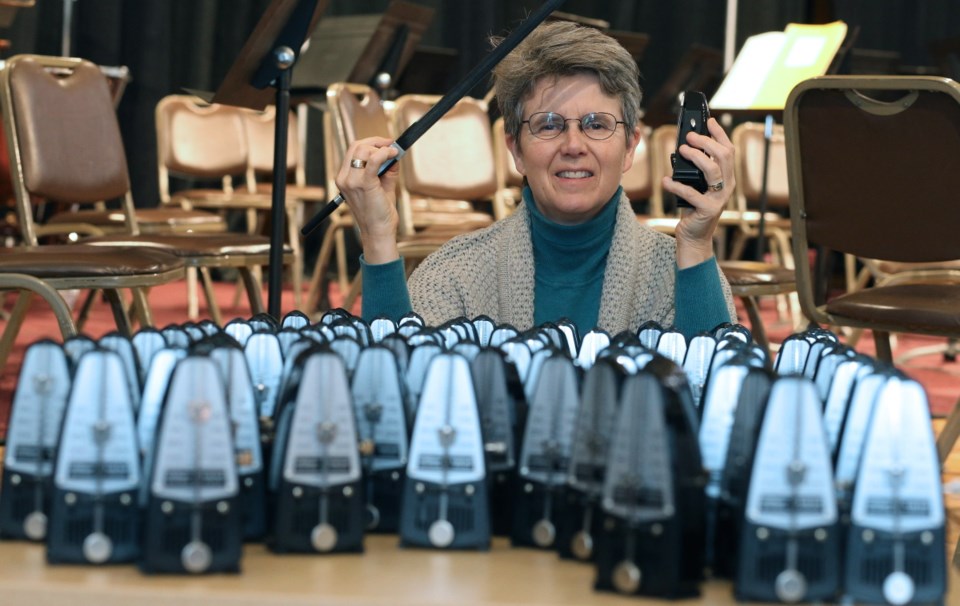What: Ligeti Festival
When/where: Tonight, Friday, and Saturday; various times and venues.
Tickets: Free to $20; festival pass $25. Call 250-385-6515; Friday tickets also online at voxhumanachoir.ca.
Details: victoriasymphony.ca/ligetifestival
The Victoria Symphony’s concert on Saturday, part of its festival honouring György Ligeti (1923-2006), will open with the Hungarian composer’s kookiest and most notorious piece, Poème symphonique (1962) for 100 metronomes.
Your heard me — 100 metronomes. They are wound, set to different speeds, placed in equal-size groups on a resonant surface, and, on a conductor’s cue, set in motion as simultaneously as possible by two or more “interpreters,” who then leave the stage.
When the last metronome stops ticking — after 15 to 20 minutes, Ligeti suggests — the piece is over.
There are recordings and live performances can be viewed online.
Saturday’s concert will be the culmination of the Ligeti Festival, which was launched last Friday by the University of Victoria’s Sonic Lab and will also include concerts tonight and Friday by (respectively) the Emily Carr String Quartet and the chamber choir Vox Humana.
The festival includes some of Ligeti’s most substantial and celebrated works (Lux aeterna, the violin and piano concertos) as well as smaller chamber and solo pieces. Poème symphonique, admittedly, is an anomaly in Ligeti’s output, but it has aroused enough controversy to become famous. The première, in Holland in 1963, was to have aired on television, but, Ligeti said, caused such a “terrible scandal” that “instead, they showed a soccer game.”
Poème symphonique grew out of Ligeti’s brief flirtation with the avant-garde movement Fluxus. It is tempting to roll one’s eyes and dismiss it as typical conceptual-art nonsense from a time when you could write “most of them/were very old grasshoppers” on a piece of paper and call it music (a Fluxus composer actually did so).
Ligeti, who had a healthy sense of humour, admitted that Poème symphonique (its grandiose title included) was partly ironic “persiflage” intended to critique all musical ideologies, whether petit-bourgeois or avant-garde. But there is more here than a mere spoof or stunt.
“The idea of mechanical, ticking music has haunted me since my childhood,” Ligeti wrote, and Poème symphonique was a particularly pure specimen of his very serious interest in music that mimics mechanical processes.
Ligeti described its form as a “rhythmic diminuendo.” It begins as a blur of ticking, but, as metronomes begin to run down, ever-shifting layers of conflicting rhythmic patterns emerge; the more metronomes that drop out, the less chaotic the music sounds, finally achieving the perfect regularity of a single beat.
It’s easy to mock this “rhythmic diminuendo” — from hail on a tin roof to 50 kids in a tap-dancing class to a couple of old guys playing spoons to a loose windshield wiper.
But the unprejudiced concertgoer who accedes to Ligeti’s request for “patient, unhurried listening” may be mesmerized by his aural kaleidoscope and genuinely moved by the ghostly ticking of that last, lone metronome and the silence that follows its cessation.
Though hardly “early music,” Poème symphonique raises a curious period-instrument problem. Performing it “authentically” requires metronomes that gradually run down, which is to say the old pyramid-shaped, manually wound, pendulum-operated ones.
You know, the ones that give you post-traumatic stress disorder flashbacks if you are over 40 and took music lessons as a child.
But they are becoming scarce, having been replaced by electronic models (which Ligeti forbids) and mobile apps. One reads of performers struggling to assemble the required machines in cities as big as New York.
Fortunately, a few companies stock sets of 100 metronomes expressly for rental to performers of Poème symphonique, including a metronome manufacturer in Germany and a percussion dealer in London.
The Victoria Symphony is renting its metronomes from Gregory Oh, a Toronto-based pianist and conductor who has been an ardent champion of Ligeti’s piece since he discovered the score (well, “performance instructions”) long ago. Last year, dismayed at the German manufacturer’s rental fee, he bought his own set of 100 black Wittner Model No. 836 Taktell Piccolo metronomes. Before long, he had rented them out twice for performances.
Oh, who is charging the Victoria Symphony “a modest fee” (plus shipping), does not expect to earn back what he spent on his metronomes.
“I did this mostly for me,” he says. Indeed, he has played Poème symphonique at home, just for himself. He believes that live performances make its artistic merit most readily apparent.
To see it performed, he says, is to fall under its spell.
